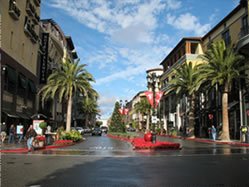Mixed-Use Trip Generation Model
Neighborhoods that mix land uses and make walking safe and convenient allow residents and workers to drive significantly less, thereby reducing traffic and realizing other benefits.
To help give communities better tools to analyze new development, EPA, in cooperation with the Institute of Transportation Engineers (ITE), worked with leading researchers and practitioners to develop new data and methods to estimate the trip-generation impacts of mixed-use developments.
On this page:
Purpose of the Tool

Trip generation analysis, the technical methodology to estimate how much traffic a new development will create, have been standardized by ITE and are used by traffic engineers across the country.
However, these methods are generally based on data collected from single-use, automobile-dependent, suburban sites, and therefore they do not adequately account for the effects of compact development, mix of uses, site design, walkability, transit, and regional accessibility – key elements of smart growth strategies and of a sustainable community.
To address this challenge, EPA created a spreadsheet tool that makes it easy for local stakeholders to estimate the internal capture of trips generated by a new mixed-use development.
The spreadsheet estimates vehicle trips generated by a new mixed-use development in peak periods and for an entire day. The method also predicts trips by walking and transit and estimates the daily vehicle miles of travel associated with the development.
How the Tool Was Created
In order to create the tool, EPA analyzed six metropolitan regions, merging data from household travel surveys, GIS databases, and other sources to create consistent land use and travel measures. The tool requires information about the development site and its surrounding area, including geographic, demographic, and land use characteristics.
It includes default national parameters for trip generation, but allows the use of local values if available. An associated report, available upon request, describes the research basis for the method and the data used to calibrate and validate it.
This method was used in several regions in California, Washington, and New Mexico, and the Virginia Department of Transportation adopted it as a statewide standard for determining the traffic impacts of urban mixed-use developments.
Additional Resources
The following resources give more information on development, testing, and use of the method and tool:
- Traffic Generated by Mixed-Use Developments – A Six-Region Study Using Consistent Built Environmental Measures, Ewing et al., ASCE Journal of Urban Planning and Development, 2011. This peer-reviewed article describes the analytic basis for the models, database development, and reports on validation tests. (Fee or subscription required.)
The following resources describe standard trip generation methods and other efforts to better understand the impacts of mixed-use developments and related smart growth strategies:
- Enhancing Internal Trip Capture Estimation for Mixed-Use Developments, National Cooperative Highway Research Program Report 684, 2011. This method, similar in scope to the EPA method described above, estimates peak-period internal capture rates for mixed-use developments for use in standard ITE trip generation applications.
- Effects of TOD on Housing, Parking, and Travel, Transit Cooperative Research Program Report 128, 2008. This report gives insight into the characteristics of residents of transit-oriented development, including their trip generation rates.
